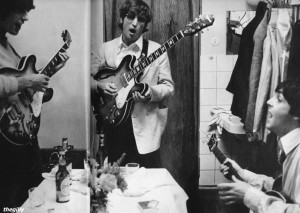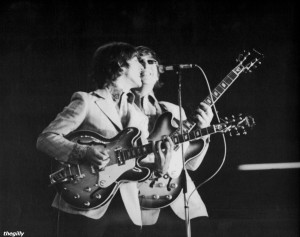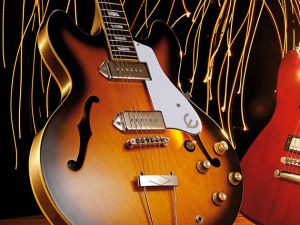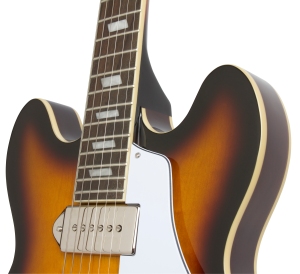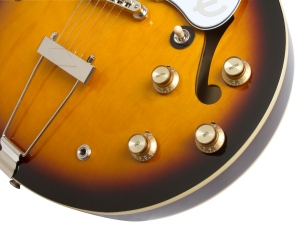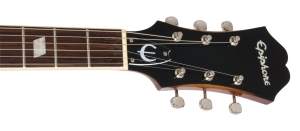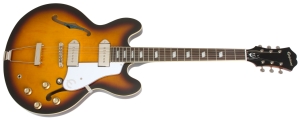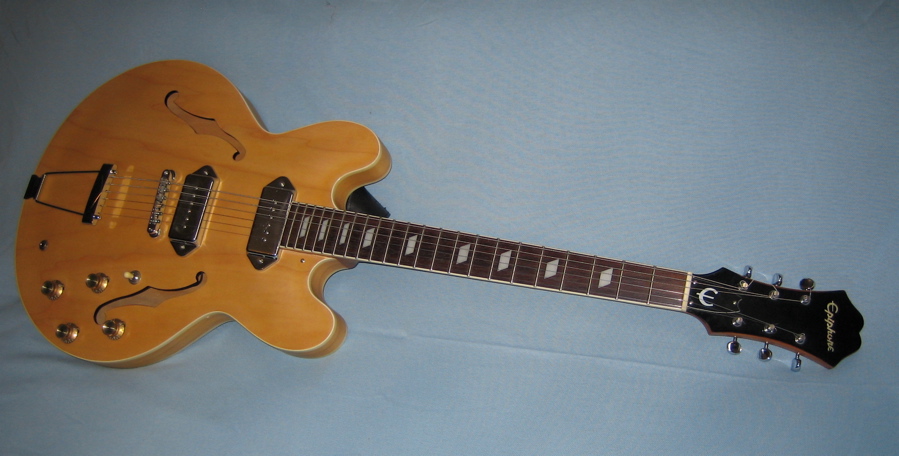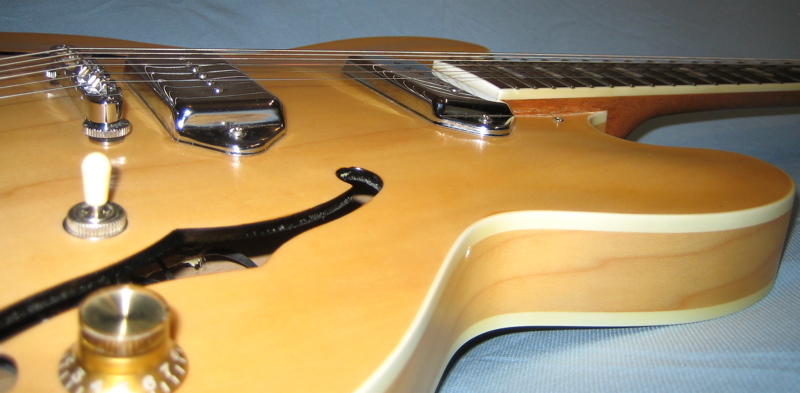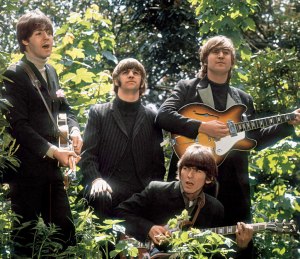Tag Archives: The Beatles
Vintage Guitar Magazine: The Beatles’ Casinos
Of all the guitars the Beatles made famous, the only one that John, Paul and George had in common was the Epiphone Casino. Each owned a Casino and used it for countless recordings and performances.
Paul McCartney was the first Beatle to acquire a Casino. Influenced to purchase it by his friend, blues musician John Mayall, McCartney said, “You’d go back to his place and he’d sit you down, give you a drink, and say, ‘Just check this out.’ He’d go over to his [tape] deck, and for hours blast you with B.B. King, Eric Clapton… he was sort of showing me where all of Eric’s stuff was from. He gave me a little evening’s education. I was turned on after that, and [bought] an Epiphone.” Mayall recalls the late-night record sessions. “I showed him my hollowbody guitar that I’d bought when I was in the army in Japan in 1955. When people get together and listen to records, they talk about all kinds of things related to the music, so obviously we must have touched upon the instruments and it struck home. He got a hollowbody after to get that tone.”
The Epiphone Casino ES-230TD that McCartney purchased at the end of ’64 has an early-style Gibson-design headstock rather than Epiphone’s later hourglass-shaped headstock. Photographs taken in December of ’64, during rehearsals for the Beatles’ Christmas performances at London’s Hammersmith Odeon, show Paul playing a new Epiphone Casino still strung right-handed. Another picture shows McCartney and Harrison examining the right-handed Casino, evidently discussing how they would alter the guitar so the left-handed McCartney could use it.
McCartney’s sunburst Casino has serial number 84075, and according to Gibson’s records shipped November 1, 1962. McCartney altered it for playing left-handed, turning the guitar upside down, re-stringing it, and modifying the bridge for correct intonation. A strap button was added to now-inverted upper treble bout. McCartney used his Casino extensively in the studio with The Beatles, including the memorable lead-guitar break on “Ticket To Ride.” He also used it throughout his solo career, and still owns the guitar.
In the spring of ’66, during recording sessions for Revolver, John Lennon and George Harrison decided to join the Casino club. The most obvious difference between these two virtually identical guitars was Harrison’s had a Bigsby vibrato, while Lennon’s had the standard Epiphone “trapeze” tail. Lennon’s was unusual in that it had a small black ring mounted around its pickup selector switch. Both had the more common Epiphone-style headstock and were fitted with gold-colored Volume and Tone knobs.
The first time Lennon and Harrison performed with their almost-matching Casinos was when The Beatles made an appearance on the popular British TV show “Top Of The Pops.” On June 16, 1966, they entered BBC’s London studios to mime both sides of their new single, “Rain” and “Paperback Writer.”
As the group started its ’66 tour of Germany, Japan, and the U.S., Lennon and Harrison chose the Casinos as their main instruments for the tour.
By ’67, The Beatles embarked on the sessions that would produce their masterpiece album, Sgt Pepper’s Lonely Hearts Club Band. Present and used throughout were all three Casinos. And it was during these sessions that Lennon painted his by spraying a white or grey outline on back of the body and neck.
In early ’68, The Beatles headed to Rishikesh, India, to study transcendental meditation with The Maharishi and friends, including Donovan Leitch. There, Donovan convinced the trio to sand the finish off their instruments, telling them how a guitar sounds better without a heavy finish. After returning to London, during sessions for the self-titled “white album,” Lennon and Harrison sanded their Casinos. Lennon primarily played his newly stripped Casino for the sessions. Harrison said that once they’d removed the finish, they became much better guitars. “I think that works on a lot of guitars,” he explained. “If you take the paint and varnish off and get the bare wood, it seems to sort of breathe.” With the completion of the white album, promo clips were filmed for the single “Revolution”/“Hey Jude.” The clips showed Lennon using his natural Casino.
On December 11, 1968, Lennon appeared as a special guest for the filming of The Rolling Stones’ television special, “Rock ’n’ Roll Circus,” which included a memorable performance by the supergroup Dirty Mac, whose members included Eric Clapton on guitar, Keith Richards on bass, Mitch Mitchell on drums, and Lennon playing his Casino. Dirty Mac’s legendary performance of “Yer Blues” was one of the show’s highlights.
Lennon continued to use his Casino during the Beatles’ “Get Back”/“Let It Be” filming and recording sessions. On January 30, 1969, filming climaxed with The Beatles’ celebrated performance on the rooftop of their Apple Corps office building, in London. It was the last public performance given by The Beatles as a band and was documented by a slew of film cameras and still photographers – and an 8-track tape recorder rolling in the Apple basement studio. Lennon played his Casino.
The last studio effort found the Beatles back at EMI’s Abbey Road Studios, where they recorded their swan song, Abbey Road. “The End” was intended to be the last song on Abbey Road, and gives the listener an all-too-brief glimpse of a great three-way guitar duel. McCartney, Harrison, and Lennon, in that order, each take a two-bar solo, cycling around three times. McCartney used his Casino, Harrison’s work is pure wailing Gibson Les Paul, and Lennon makes an aggressive, distorted howl with his Casino.
John, Paul, and George would continue to use their Casinos on numerous solo projects and recordings. McCartney still uses his, even referring to it as his favorite electric. “If I had to choose one electric guitar, it would be this,” he said.
Andy Babiuk is the author of Beatles Gear, which was recently released in a newly revised edition. He is also author of The Story of Paul Bigsby: Father of the Modern Electric Solidbody Guitar and with Greg Prevost is preparing Stones Gear, a history of the equipment used by the Rolling Stones. He can be reached at andy@tonebendermusic.com.
’66 Epiphone Casino
By George Gruhn & Walter Carter
In the Epiphone line of the 1960s, the Casino occupied middle ground. In appearance as well as electronics it ranked well below the semi-hollow Sheraton and Riviera or the solidbody Crestwood Custom. But thanks to the Beatles, it is probably the best-known of all Gibson-made Epi models.
Like most of the Epiphone line of the ’60s, the Casino bore little resemblance to the Epiphones of a decade earlier, much less the ’30s archtops on which the company had built its reputation (be sure to read the feature on the Epi harp guitar in this issue).
With roots in Greece and Turkey, Epiphone was founded as the House of Stathopoulo in the early 1900s. Epaminondas “Epi” Stathopoulo, one of the founder’s three sons, led the company to a prominent position in the tenor-banjo market of the ’20s (an era in which Gibson struggled to develop a competitive banjo model). Epi had the foresight to recognize the rising popularity of the guitar in the late ’20s and, in particular, the role the archtop guitar – an instrument invented by and produced almost exclusively by Gibson – would play in popular music of the coming years.
In 1931, Epiphone attacked Gibson’s dominance with a line of archtops called Masterbilt, playing on the notoriety of Gibson’s L-5 “Master Model.” Gibson responded with more and larger models, and Epi countered with an even larger model. The competition extended to the electric line, where in 1937 Epiphone introduced a pickup with individually adjustable pole pieces, and Gibson followed suit in 1940.
During the production hiatus for World War II, Epi Stathopoulo died of leukemia, and when guitar production resumed after the war, the company struggled. Its six-pushbutton pickup selector system on the three-pickup Emperor was an arguable improvement over the six knobs Gibson used on its three-pickup ES-5, but in most areas of the market, Epiphone lagged behind Gibson. Epi’s brothers were unable to bring the company back to its pre-war prominence, and in ’57 they sold Epiphone to the Chicago Musical Instrument Company, Gibson’s parent.
Ted McCarty, general manager of Gibson, viewed Epiphone as an opportunity for Gibson to expand its dealer network while maintaining territorial exclusivity for existing Gibson dealers. McCarty continued some of Epiphone’s archtop models in the new lineup, and other Epi features, such as multi-ply necks and metal-covered single-coil pickups, also provided continuity between the old Epis and the Gibson Epis. However, most models in the Gibson-made line were completely new.
Gibson had been making thinline electric guitars since 1955 (the Stathopoulos had never introduced a thinline Epiphone), and Gibson introduced the thinline double-cutaway, semi-hollow ES-335 in 1958. Almost concurrently, a similar (and fancier) model appeared in the Epi line – the Sheraton. A year later, Gibson introduced a stepped-down model with the same body shape but with a fully hollow body and single-coil pickups, called the ES-330. In ’61, a model similar to the Gibson ES-330 showed up in the Epiphone line as the Casino.
Structurally, the Casino was the same as the ES-330, with a thinline, double-cutaway hollow body. Functionally, too, it was the same guitar, with one or two “dog-ear” P-90 pickups (with black covers), a Tune-O-Matic bridge, and a trapeze tailpiece. A vibrato was optional. Cosmetically, both models had single-ply binding on the top, back, and fingerboard, pearl dot fingerboard inlays, and an inlaid peghead logo with no other ornamental peghead inlay. The Casino was offered in sunburst or Royal Tan finish while the ES-330 was offered in sunburst or natural.
When Gibson upgraded the ES-330 in ’62 with chrome-plated pickup covers and small block fingerboard inlays, the Casino was also upgraded to chrome-plated pickup covers and single-parallelogram inlays (a pattern not standard on any Gibson).
Gibson designed the Epiphone line to have prices slightly below the equivalent Gibsons, but the only significant difference between the standard Casino and the ES-330 was the brand name. In ’63, Gibson apparently valued the Gibson brand at $15 more than Epiphone. The two-pickup Casino listed that year for $275 and the sunburst ES-330 was $290 (Cherry finish, which had replaced natural, was $305).
Despite the lower prestige of the Epiphone name, the Casino actually topped its Gibson counterpart slightly when it came to the vibrato. The Epiphone vibrato had an anchor bar with a graduated diameter to compensate for the different string diameters. The result was a more consistent pitch change across the strings. Whether the improvement was noticeable to the ears of listeners is arguable, but the Epi-style unit at least had the appearance of an improvement over the simple U-shaped spring design of the Gibson “Maestro” unit, and the Epi unit was not offered on any Gibson model. In fact, the 1963 catalog did not offer any kind of vibrato as an option on the ES-330, while the vibrato-equipped Casino remained a catalog model.
The relative merits of the Casino and the ES-330 – and most other Epis and Gibsons models, for that matter – became irrelevant when Casinos appeared in the hands of the Beatles. Paul McCartney bought a sunburst in 1964, and John Lennon and George Harrison each bought sunbursts in ’65. In ’67, Harrison played his Casino equipped with a Bigsby on a video for “Hello Goodbye,” and Lennon played his on a TV broadcast of “All You Need Is Love.” By September ’68, when the group appeared on the BBC show “Top of the Pops,” Lennon had scraped the finish off his Casino, and Harrison did the same to his shortly thereafter. Lennon played this now-natural Casino on the Beatles’ final appearance together on January 30, 1969, on the rooftop of the Apple building.
If the Beatles had any influence at all on Epiphone sales, it was too little, too late. Through the ’60s, Epiphone sold more than 6,700 Casinos – more than double the sales of any other model – but that was not enough to save it. By the end of ’69, Gibson had scrapped the entire Epiphone line and replaced it with a new line imported from Japan. By the time the Beatles’ rooftop performance was seen by the public in the film documentary Let It Be, it was May 1970, and nothing in the Epiphone line resembled a Casino.
Epiphone Casino – the official story for 2014
The long winding road of a rock maverick

The Epiphone Casino might be the House of Stathopoulo’s most iconic instrument thanks to its association with The Beatles. In fact, two Kalamazoo designed guitars–the J-160E acoustic/electric (which you can get today as the Epiphone John Lennon EJ-160E and the Epiphone Casino–together share the distinction of being the only two guitars heard on every Beatles recording session.
acoustic/electric (which you can get today as the Epiphone John Lennon EJ-160E and the Epiphone Casino–together share the distinction of being the only two guitars heard on every Beatles recording session.
But over the last decade thanks to a diverse group of artists like Gary Clark Jr., Radiohead, Paul Weller, and Brendan Benson of the Raconteurs, the Epiphone Casino has transcended its Beatle connection and become a must-have for any player’s collection.
Though the Casino, first released in 1961, was essentially Epiphone’s version of the Gibson ES-330, the Gibson version never caught on like the Casino. Whether it was the times or the number of instruments produced, the Casino–a full hollowbody with two P-90s (another Kalamazoo invention)–was destined to be thought of as an Epiphone classic. And like any great guitar–by design or by accident–it’s perfect just the way it is.
Today, Epiphone makes Casinos just as they did at the Kalamazoo factory in 60s. “Our modern Casino is based on the best vintage models we could find,” said Epiphone President Jim Rosenberg. “The only difference is that today, every Casino is consistently great–perfect neck, great sound, and great look, where as vintage models can be vary quite a bit.”
In 1961, the Casino was merely another instrument in a series of “Thinline” electrics first introduced in the late 50s that helped announce a new era for Epiphone after it became part  of Gibson brands and moved to Kalamazoo, Michigan. The idea of a Thinline electric that had the look of an archtop was not that much of a departure for Epiphone since the company had established a stellar reputation (much to the annoyance of Gibson) as an excellent archtop builder. But where as most of the original Thinline series like the Sheraton and the 335 featured a mahogany center block on which the pickups were mounted the Casino held the distinction of being a true hollowbody. It was also less expensive than other Gibson Thinline models, which caught the attention of young rockers like Garry Tallent, future bassist of the E Street Band.
of Gibson brands and moved to Kalamazoo, Michigan. The idea of a Thinline electric that had the look of an archtop was not that much of a departure for Epiphone since the company had established a stellar reputation (much to the annoyance of Gibson) as an excellent archtop builder. But where as most of the original Thinline series like the Sheraton and the 335 featured a mahogany center block on which the pickups were mounted the Casino held the distinction of being a true hollowbody. It was also less expensive than other Gibson Thinline models, which caught the attention of young rockers like Garry Tallent, future bassist of the E Street Band.
“Epiphones were great guitars back then and affordable,” recalled Tallent. “Even today, whenever I go to a guitar show, if I see an Epiphone electric or acoustic that’s in great shape, I get it. They always sound perfect.”
As for just who originated the Thinline series, that remains somewhat of a mystery. “There were other companies at the time like National who were making something similar,” said Walter Carter who published The Epiphone Guitar Book, a history of Epipohne, in 2013. “If it were Ted McCarty’s idea he certainly would have taken credit for it (laughs). But the Casino’s popularity in particular had mostly to do with The Beatles. It was and is a great guitar for rock and roll with a different sound.”
Epiphone re-created the original (1961) Casino in 2011 with the same 16″ wide body made of 5-layer Maple/Birch and a 24-3/4″ scale mahogany SlimTaper™ neck with a Rosewood fingerboard attached using the traditional mortise and tenon neck joint. The 50th anniversary Casino also featured black Gibson USA P-90 pickups and a slightly modified Tremotone tremolo that works much better than the original. Epiphone’s 50th Anniversary Casino (a favorite touring guitar for Gary Clark Jr.) also featured 16 frets clear of the body and came in a Sunburst or Royal Tan finish.
Over the next few years, there were small changes made to the Casino. Epiphone moved away from the “bullet” logo in 1962 to the pearloid-inlaid Epiphone script logo that remains  today. During the time that Paul McCartney purchased his Casino in 1964 and John Lennon and George Harrison purchased their Casinos before the Revolver tour in 1966, fingerboard inlays changed from dot to parallelogram inlays and the tortoise shell pickguard changed to white. Pickup covers, which were nickel from 1963-1964, changed to chrome.
today. During the time that Paul McCartney purchased his Casino in 1964 and John Lennon and George Harrison purchased their Casinos before the Revolver tour in 1966, fingerboard inlays changed from dot to parallelogram inlays and the tortoise shell pickguard changed to white. Pickup covers, which were nickel from 1963-1964, changed to chrome.
The Beatles discovery of the Casino came just before Christmas in 1964. McCartney told Vintage Guitar that he was inspired to buy a guitar that could “feedback” after he spent an evening at John Mayhall’s house listening to records. “You’d go back to his place and he’d sit you down, give you a drink, and say, ‘Just check this out,'” said McCartney.
“He’d go over to his [tape] deck, and for hours blast you with B.B. King, Eric Clapton… he was sort of showing me where all of Eric’s stuff was from. He gave me a little evening’s education. I was turned on after that, and [bought] an Epiphone.”
John Mayall probably played McCartney cuts by B.B. King as well as razor sharp 45s on Cobra Records by Magic Sam and Otis Rush, both regular Epiphone players. “I showed him (McCartney) my hollowbody guitar that I’d bought when I was in the army in Japan in 1955,” Mayall told Vintage Guitar. “When people get together and listen to records, they talk about all kinds of things related to the music, so obviously we must have touched upon the instruments and it struck home. He got a hollowbody after to get that tone.”
Recording feedback was already a part of The Beatles sound at this point with the release of “I Feel Fine,” which was recorded in October 1964 and was inspired by John’s 160E feeding back against an amp. The Epiphone could feedback too, but thanks to smaller body size, a guitarist could more easily control the tone and “howl” of the feedback by turning the Casino away from an amp or “playing” the feedback with the guitar’s volume and tone controls.
 McCartney still brings out his original 1963 Epiphone (shipped from Kalamazoo, Michigan on November 1, 1963) in concert for “Paperback Writer” and select cuts from Sgt. Pepper. Radiohead Producer Nigel Godrich, whose pal Thom Yorke plays a 1965 Casino, singled out McCartney’s Casino as his favorite guitar while producing Chaos and Creation In the Backyard. “If I had to choose one electric guitar,” said McCartney, “it would be this.”
McCartney still brings out his original 1963 Epiphone (shipped from Kalamazoo, Michigan on November 1, 1963) in concert for “Paperback Writer” and select cuts from Sgt. Pepper. Radiohead Producer Nigel Godrich, whose pal Thom Yorke plays a 1965 Casino, singled out McCartney’s Casino as his favorite guitar while producing Chaos and Creation In the Backyard. “If I had to choose one electric guitar,” said McCartney, “it would be this.”
McCartney’s Casino or ES-230TD, featured an early Gibson-style headstock that would be changed to the classic Epiphone “hourglass” headstock by the time George and John bought their Casino’s (George’s, like Paul’s, featured a Bigsby tremolo).
Most Casinos made from the mid ’60s to the end of the decade were Sunburst though Cherry was also an optional finish after 1967. Critically acclaimed Nashville pop artist Tristen plays one of those rare Cherry Casinos (a ’67) in concert. There are also a few rare custom colored Casinos that show up from time to time, including one in Silver Fox that is Brian Ray’s favorite guitar. “It’s black with “TV” yellow grain showing finish. A kind of translucent black. I’ve never seen another one like it,” Ray told Epiphone. “I dare you to find one like it. You’ll find a Rivera but you won’t find a Casino. They’re so rare. People need to know the whole history of Epiphone. It didn’t just start with The Beatles. Epiphone is awesome and the world needs to know about it.”
 In the heyday of the British Invasion, the Casino was also Rolling Stone Keith Richards’ main guitar (who used his to record “Satisfaction”) and Brian Jones can be seen playing one on the cover of the reissue EP of Got Live If You Want It. There are also tv clips of The Hollies, The Kinks, and the Moody Blues using their Casinos on shows like Ready, Steady, Go!
In the heyday of the British Invasion, the Casino was also Rolling Stone Keith Richards’ main guitar (who used his to record “Satisfaction”) and Brian Jones can be seen playing one on the cover of the reissue EP of Got Live If You Want It. There are also tv clips of The Hollies, The Kinks, and the Moody Blues using their Casinos on shows like Ready, Steady, Go!
The Casino was discontinued throughout the 70s and when Epiphone got back into action in the 90s, both vintage and new Casinos enjoyed a renaissance thanks to Paul Weller  (whose 1964 Casino is seen at right), Lenny Kravitz, Noel Gallagher of Oasis, U2’s the Edge, Jeff Tweedy of Wilco, Brendan Benson of the Raconteurs, instrumentalist William Tyler, and of course, Dwight Yoakam who has carried the flag for the Casino for years before designing his Dwight Trash Signature model.
(whose 1964 Casino is seen at right), Lenny Kravitz, Noel Gallagher of Oasis, U2’s the Edge, Jeff Tweedy of Wilco, Brendan Benson of the Raconteurs, instrumentalist William Tyler, and of course, Dwight Yoakam who has carried the flag for the Casino for years before designing his Dwight Trash Signature model.
“I always loved the aesthetics about the Casino. There’s something about the white pickguard as well as the sound… I really fell in love with it.”
P-90s are key to the Casino’s canny combination of chime and grit. The P-90 is a touch sensitive pickup by nature and is perfect for both lead and rhythm sounds. P-90s carry more “weight” sonically than the typical single coil pickup and have the effect of sounding especially “electric” when combined with the Casino body. Just listen to Beatle tracks like “Paperback Writer” and “She Said, She Said” to hear how nuanced a basic chord can sound when played on a Casino.
Gary Clark Jr. is probably today’s most outspoken and visible Casino fan. Over the last year alone Clark has been seen with both a standard Casino, an Elitist, and a ’61 50th anniversary model.
 “I had my eyeballs on Casinos for a while until I finally got one,” Clark told Epiphone. “I just recently got two “Blak and Blu” Casinos which I’m so stuck on at the moment. They’re all so amazing. ‘Blak and Blu’ with a Bigsby! They’re a dream.”
“I had my eyeballs on Casinos for a while until I finally got one,” Clark told Epiphone. “I just recently got two “Blak and Blu” Casinos which I’m so stuck on at the moment. They’re all so amazing. ‘Blak and Blu’ with a Bigsby! They’re a dream.”
Even if The Beatles had not discovered the Casino, the list of fans would still include virtually every major pop, country, blues, and rock artist of the last 50 years. “It’s really a perfect electric guitar,” said Jim Rosenberg, “it can be clean, it can be knarly and it sounds terrific at low volume and feeding back. And it’s a lot like Epiphone, too. A bit of a maverick.”
The Beatles on tour (1966) by Robert Whitaker
Music Radar Review – Inspired By John Lennon Casino
While the calibre and heritage of Epiphone’s discontinued, USA-made John Lennon 1965 Casino can hardly be questioned, it had one major drawback: the price!
Retailing on the cusp of £2000, for many guitarists not even the high build quality could compensate. This tale isn’t unique among Epiphone’s American-made guitars.
Keen to redress the balance for those with smaller pockets, Epiphone has launched the new Indonesian-made ‘Inspired By’ John Lennon Casino – £1,200 cheaper than the former USA model and £400 more expensive than the standard Chinese-made Casino.
One event more than any other led to the Casino’s enduring popularity. In 1966, with Paul McCartney already using his 1962 Casino on many famous tracks such as Taxman and Paperback Writer, John Lennon acquired his very own sunburst model.
It’s argued that McCartney’s use of the model was the more impressive from a musical perspective, but Lennon definitely did more for it visually than any guitarist before or since.
Contemporary players such as Paul Weller and Noel Gallagher have also become synonymous with Epiphone semis but, as we know, their inspiration draws directly from The Beatles and The Rolling Stones.
Here, Epiphone has borrowed Gibson Custom’s Historic ‘Inspired By’ moniker as a means to upgrade the standard Casino with USA appointments, but retain that famous artist relation at a modest price – perhaps due to the fact that Epiphone has, as mentioned, discontinued the USA-built equivalent.
Hear it in action in the following audio demo:
http://cdn.mos.musicradar.com//audio/review%20audio/Guitar/jan10/casino.mp3
The upgraded fittings include two Gibson USA P-90 pickups with dog-ear, nickel-plated covers and a Switchcraft-made three-way toggle switch and output jack.
Like the ES-330, the Casino’s maple laminate body is completely hollow and shares the distinctive twin-cutaway shape with single-layer, off-white binding on the front and back edges, which in this case is extremely well done.
The ‘Inspired By’ also features a more vintage-correct sunburst than its Chinese counterpart, where the ‘burst is wider to the edges and has a more luxurious, deeper gradient as seen on sixties examples. However its scratchplate, as on our regular Casino, is still a little cheap looking and it’s common for players to remove it.
In keeping with the original, the 22-fret neck joins the body at the 16th fret, which is three further back than a centre-blocked ES-335 and one further than our Chinese-made standard Casino.
We also see the inclusion of parallelogram-shaped block inlays placed neatly into the rosewood fretboard, as seen on original Casinos of that period. The slim-taper neck, with its medium gauge fretwire and a 355mm (14-inch) radius makes for a very comfortable feel and low-playing action.
Mind you, the high-gloss finish on the back of the neck is a bit ‘sticky’– some players might have preferred a more ‘played in’ feel.
Further testament to Epiphone’s vintage-correct efforts can be seen in the smaller details: small button vintage Kluson-style tuners, a black ring around the toggle switch, Gibson-style control knobs and a rectangular blue label in the soundhole.
A nickel-covered trapeze-style tailpiece, as seen on the ES-330, and a twin-pillar-mounted tune-o-matic bridge complete the hardware. Surprisingly, the only visual clue to its famed user is a small and subtle gold signature on the back of the long, ‘moustache’-topped headstock.
Sounds
Starting our sound test with a modest amount of overdrive (and using our Chinese-made Casino for comparison) the Lennon has a wonderfully mellow, airy tone that really fills out a band’s sound and is synonymous with this hollowbody design.
It’s different to the classic ES-335 centre-blocked design, which lends itself to more pumped-up rhythm tones. The American pickups sound notably different to those on the standard Casino, letting the natural acoustic and percussive resonance shine through, bolstering the character and charm of the hollow design.
The bridge P-90 is both angular and sprightly, and does those cutting BB King-style solos with seeming aplomb. Alongside this, the middle and neck positions offer open and expressive jazz and blues-rhythm tones that some of the greats, such as Grant Green for example, built their careers on.
The key to the Beatles tone is in the volume control. Setting your sound with a little more gain and dialling down the guitar’s volume changes the character of the Casino.
Here, you’ll find that acoustic quack and clean bite needed to pull off the kind of tone found on the opening of Taxman – be careful though, due to its hollow construction it will feed back a fair bit, so be wary of your amp’s volume and the amount of gain used.
Overall, this ‘Inspired By’ Casino has that vintage-like tone down to a tee and is wonderfully musical. In comparison, the far cheaper standard Chinese-made Casino lacks the charm and charisma of the ‘Inspired By’ model – both tonally and visually.
In general, artist edition guitars seem to be getting increasingly expensive, so it’s nice to see Epiphone taking a more affordable tack with this Casino. By adding subtle vintage aesthetics that really capture the essence of the original and employing quality American upgrades, it’s a superior package than the standard Casino and way more affordable than the previous USA model.
The price may still seem steep for some, but consider this: the upgrades alone would set you back the £400 difference between this and the standard Casino, it includes an Epiphone Limited Lifetime warranty and a quality hard case, plus a portion of the proceeds from each sale gets donated to the John Lennon Scholarship Fund for music education.
MusicRadar Rating
Pros
Vintage vibe. American appointments. Range of sounds.
Cons
The scratchplate looks cheap, but little else.
Verdict
A sub-£1000 hollowbody with US upgrades, wonderful vintage Casino aesthetics and sound, plus an affiliation with its most famous user. What’s not to like?
I Love My Epiphone Casino
Kitarablogi.com – Finland's premier Guitar and Bass blog
One of my all-time favourite guitars is the EpiphoneCasino. It is the ultimateBeatle-guitar – all three guitar-playing Beatles have owned and played this model. Paul McCartney still rates the Casino as his personal favourite.
Originally called the Epiphone Casino ES-230TD it was the sister model to Gibson’s ES-330. Gibson had bought (the then US-firm) in the mid 1950s and produced Epiphone models alongside their own line in Kalamazoo (Michigan). Nowadays the Epi brand serves as Gibson’s cost-conscious line and the production has long been moved to the Far East (mostly China).
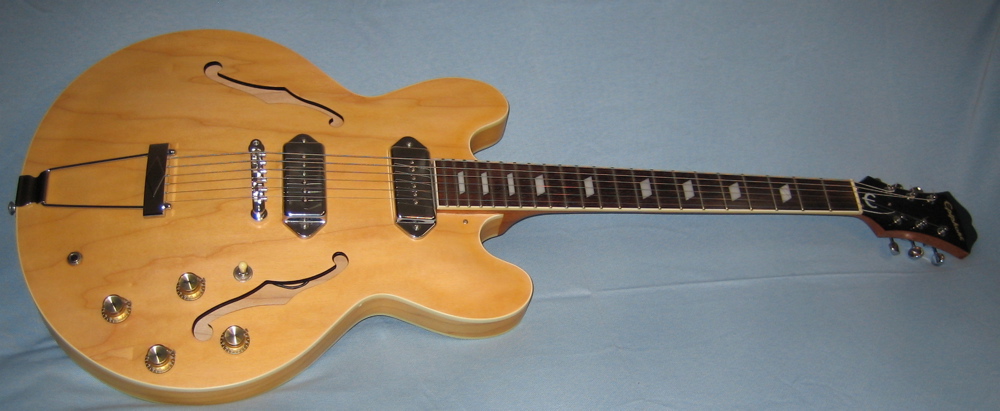
My Casino is an early Noughties Korean-manufactured guitar. Originally a natural (gloss) finished model, it has been Lennon-ised by my friend Sebastian Bunge of Soundhaus Lübeck (Germany). He dulled down the finish (at which point the serial number went missing) and installed higher quality P-90 pickups made by Göldo.
Although the Casino shares…
View original post 247 more words
IN PRAISE OF: Epiphone Casino
Back in 1966, John Lennon and George Harrison of The Beatles were on the sniff for some new guitars to replace their shagged- out Beatlemania-era Rickenbacker and Gretsch models.
As it happens, fellow Fab Paul McCartney had bought himself a ’62 Epiphone Casino the previous year. Macca used his Casino to record the guitar solos on Drive My Car (from Rubber Soul, 1965) and Taxman (Revolver, 1966).
Knocked out by the guitar’s playability, looks and tone, John and George followed Macca’s lead and each bought a ’65 Casino to record Revolver and to use on the band’s last ever world tour in 1966.
Launched in 1961, the ES-230TD Casino was basically a re-branded version of the thinline ES-330 model, which Gibson produced between 1959 and 1972.
The only real differences between the two guitars were the headstock shape and the design of the trapeze tailpiece, which was used on the non-Bigsby vibrato- equipped model.
Like the ES-330, 60s Casinos had fully hollow, five-ply laminated birch and maple bodies – they don’t have a centre block like a Gibson ES-335 or Epiphone Sheraton – and a pair of singlecoil P90 pickups.
The Beatles connection is a huge part of the appeal of the Casino, but the bright chime of those P90s is crucial, too. Ease of playability is legendary thanks to slim necks, fattish frets and low actions.
While Beatle George later moved on to a red Les Paul and a beautiful rosewoodTelecaster, Lennon had the finish stripped from his Casino, and used it right up to the break-up of The Beatles in 1970. That year also marked the end of the first run of US- made Casinos.
The model was subsequently resurrected in Japan in the late 70s, before making a huge comeback as a reissue in the mid 90s, thanks to Weller and Oasis.
US- and Japanese-made versions of Lennon’s Casino, both finished (the ’65) and stripped (the ‘Revolution’ guitar), are available, while the model’s significance was marked by the 50th Anniversary model in 2011.
Epiphone Casino timeline
1961: The Epiphone-branded ES-330, AKA Casino, is launched.
1966: John and George bag their beloved ’65 Casinos
1970: The original run of US-made Casinos ends.
2011: The 50th Anniversary Casino celebrates the model’s legacy.







